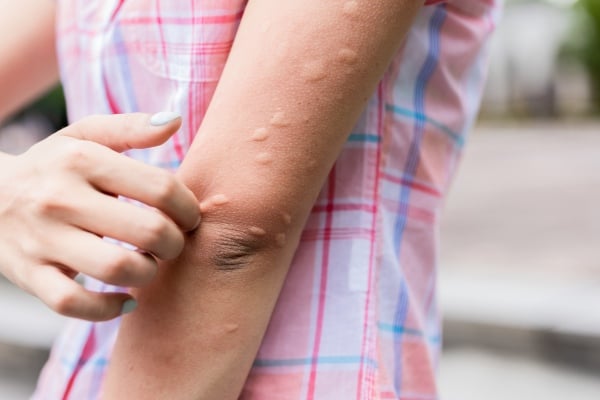
Ants and mosquitoes are two common insects that can cause discomfort through their bites. While both can lead to irritation and allergic reactions, the nature of their bites, the insects’ behaviors, and the potential health risks associated with them differ significantly. This article will explore the differences between ant and mosquito bites, including their characteristics, symptoms, treatment options, and prevention strategies.
Overview of Ant Bites
Ant bites occur when an ant uses its mandibles to grasp skin and injects venom through a stinger or through its saliva. Different species of ants have varying methods of biting, and the severity of the bite can depend on the ant species involved.
Common Types of Ants That Bite
- Fire Ants: Known for their painful stings, fire ants inject venom that can cause intense burning sensations and blisters.
- Carpenter Ants: While they do not sting, carpenter ants can bite when threatened, causing painful wounds.
- Pavement Ants: Their bites are less severe but can still cause irritation.
Overview of Mosquito Bites
Mosquito bites occur when female mosquitoes pierce the skin with their specialized mouthparts (proboscis) to feed on blood. Male mosquitoes do not bite; they primarily feed on nectar.
Common Types of Mosquitoes
- Aedes Mosquitoes: Known for transmitting diseases like Zika virus and dengue fever.
- Anopheles Mosquitoes: Primary vectors for malaria.
- Culex Mosquitoes: Known for transmitting West Nile virus.
Key Differences Between Ant and Mosquito Bites
The following table summarizes the primary differences between ant and mosquito bites:
| Feature | Ant Bites | Mosquito Bites |
|---|---|---|
| Method of Bite | Uses mandibles and/or stinger | Uses proboscis to pierce skin |
| Venom/Saliva | Injects venom through stinger | Injects saliva containing anticoagulants |
| Pain Level | Can be very painful (e.g., fire ants) | Generally causes mild discomfort |
| Reaction Type | Localized swelling, redness, itching | Red, itchy welts; may develop into hives |
| Allergic Reactions | Possible; can lead to anaphylaxis | Possible; can lead to severe reactions |
| Infection Risk | Moderate; bite site may become infected | Low; primarily irritation unless scratched |
| Duration of Symptoms | Varies by species; can last days | Typically resolves within hours to days |
Characteristics of Ant Bites
Pain and Symptoms
Ant bites vary in pain intensity depending on the species. Fire ant bites are particularly notorious for their painful stings that create a burning sensation. The bite usually results in:
- Redness and swelling around the bite site
- Itching or burning sensation
- Formation of blisters or pustules in some cases
Treatment Options
To treat ant bites:
- Clean the Area: Wash the bite area with soap and water to prevent infection.
- Cold Compress: Apply a cold pack to reduce swelling and numb pain.
- Topical Treatments: Use hydrocortisone cream or calamine lotion to alleviate itching.
- Oral Antihistamines: Consider taking antihistamines like Benadryl for allergic reactions.
Prevention Strategies
To prevent ant bites:
- Keep food sealed and stored properly outdoors.
- Avoid walking barefoot in areas known for fire ants.
- Regularly inspect your home for ant nests.
Characteristics of Mosquito Bites
Pain and Symptoms
Mosquito bites typically cause less immediate pain compared to ant bites but can lead to significant itching and irritation. Symptoms include:
- Red, raised welts at the bite site
- Intense itching
- Swelling around the area
In some cases, mosquito bites can lead to more serious health issues due to disease transmission.
Treatment Options
To treat mosquito bites:
- Clean the Area: Wash with soap and water to prevent infection.
- Cold Compress: Apply a cold pack to reduce swelling.
- Topical Treatments: Use anti-itch creams or ointments containing hydrocortisone or calamine lotion.
- Oral Antihistamines: Consider antihistamines for severe itching.
Prevention Strategies
To prevent mosquito bites:
- Use insect repellent containing DEET or picaridin when outdoors.
- Wear long sleeves and pants during peak mosquito activity times (dawn and dusk).
- Eliminate standing water around your home where mosquitoes breed.
Health Risks Associated with Bites
While both ant and mosquito bites can cause discomfort, they also carry different health risks:
Ant Bites
Some individuals may experience severe allergic reactions (anaphylaxis) from certain ant species’ venom, particularly fire ants. Infections may occur if the bite is scratched excessively or if proper hygiene is not maintained.
Mosquito Bites
Mosquitoes are known vectors for several diseases that pose significant health risks to humans, including:
- Malaria
- Dengue Fever
- Zika Virus
- West Nile Virus
These diseases can lead to severe health complications if not treated promptly.
Conclusion
In summary, while both ant and mosquito bites can cause irritation and discomfort, they differ significantly in their mechanisms, symptoms, treatment options, and associated health risks. Understanding these differences is crucial for effective management and prevention strategies.Ant bites tend to be more painful initially but are less likely to transmit diseases compared to mosquito bites. Conversely, while mosquito bites may cause less immediate pain, they pose a greater risk due to their potential role in disease transmission.By taking appropriate precautions—such as using repellents for mosquitoes or avoiding areas with high ant activity—you can minimize your risk of encountering these pesky insects. Whether dealing with an annoying mosquito or a painful ant bite, knowing how to respond effectively will ensure you stay comfortable during outdoor activities.





